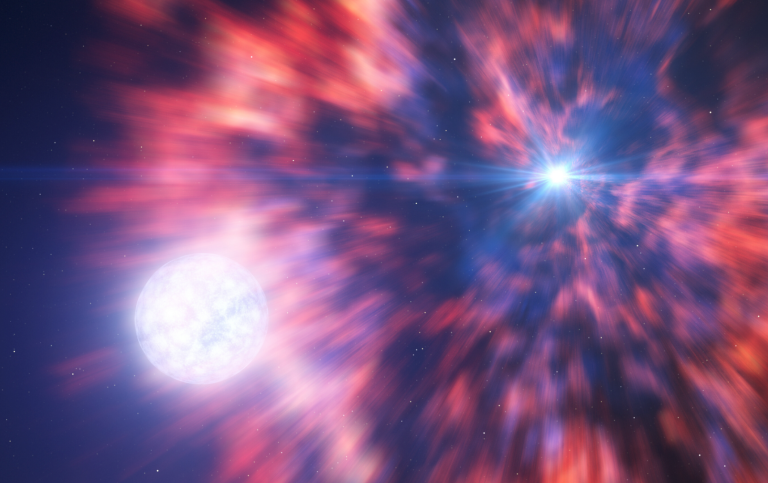A black hole-powered supernova explosion that consumes its binary companion. This is according to an explanation published in the most recent issue of the journal Nature, in which astronomers from Stockholm University take part in a study of a recent cosmic explosion.
 Artist impression of the supernova explosion. SN 2022jli occurred when a massive star died in a fiery explosion, leaving behind a compact object — a neutron star or a black hole. This dying star had a companion which survived this violent event. The periodic interactions between the compact object and its companion lead to periodic changes in the observed light curve, which revealed that the supernova explosion had indeed originated from a binary system and resulted in a compact object. Image Credit: ESO/L. Calçada
Artist impression of the supernova explosion. SN 2022jli occurred when a massive star died in a fiery explosion, leaving behind a compact object — a neutron star or a black hole. This dying star had a companion which survived this violent event. The periodic interactions between the compact object and its companion lead to periodic changes in the observed light curve, which revealed that the supernova explosion had indeed originated from a binary system and resulted in a compact object. Image Credit: ESO/L. Calçada
The explosions of massive stars are known as supernovae. In May 2022, supernova SN 2022jli was found in the neighboring galaxy NGC 157 in the constellation Cetus, 75 million lightyears away. Using the Zwicky Transient Facility at Palomar, detailed monitoring of the fading supernova revealed a periodic fluctuation in brightness, suggesting that two objects were engaging in the lethal dance.
People believe that a compact remnant is produced at the center of a massive star explosion. But the direct link between supernova explosions and newly formed compact objects is elusive. In this work, we establish such a direct link.
Ping Chen, Study Lead Author, Weizmann Institute of Science
The object’s periodic brightness fluctuations—which showed a small increase in brightness every 12.4 days—provide the link. This was linked to material oscillating inside the system, according to spectroscopic data.
We used many different telescopes to monitor this object over several months.
Jesper Sollerman, Study Lead Investigator, Stockholm University,
These included the European Southern Observatory Very Large Telescope in Chile, the ZTF camera, and the Nordic Optical Telescope on La Palma.
According to the Nature study, a compact object is periodically removing material from a companion star while it revolves around it. Although the majority of massive stars are known to have companions, clear proof of this has proven elusive in the form of supernova explosions.
“My best guess is that this transient is powered by a black hole that was created in the supernova explosion, and that was slowly accreting material from the more extended companion star,” Sollerman further stated.
Leading the team is Ping Chen from the Weizmann Institute in Israel; they published ‘A 12.4 day periodicity in a close binary system after a supernova’ in Nature. Professor Jesper Sollerman from the Department of Astronomy at Stockholm University, together with Sheng Yang from the Oskar Klein Center and Steve Schulze, two former researchers from Stockholm, also took part.
Journal Reference:
Chen, P., et. al. (2023) A 12.4-day periodicity in a close binary system after a supernova. Nature. doi:10.1038/s41586-023-06787-x